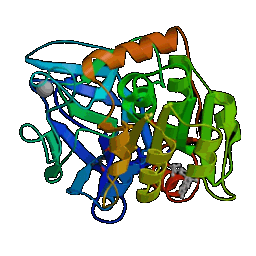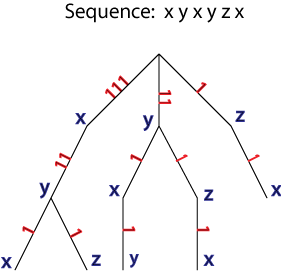
Generative Creativity - lecture 8:
Markov models
Introduction
Generative outputs from Cope's EMI system are modulated by models
(partly) derived from examples.
But how are the models obtained?
This lecture will look at the method of Markov modeling/chaining,
which plays a key role in a variety of sample-driven GC approaches
(including Cope).
In its simplest form, the method offers a way of building a
probabilistic model of a sequence.
N-grams
An n-gram is a continuous string of elements taken from a
sequence
This may be a sentence, a melody or a linguistic corpus.
For example, from the sentence `give me a break' we can extract various
n-grams.
- 1-grams (`unigrams'): `give', `a'
- 2-grams (`bigrams'): `me a', `a break'
- 3-grams (`trigrams'): `give me a', 'me a break'
Calculating n-gram probabilities
One way to obtain the n-gram probabilities is to identify each
individual n-gram and then compute its relative frequency in the
sequence.
But this is exponentially costly.
Instead, we can use the chain rule to build up the probabilities
incrementally.
- p(w1|w2) = p(w1) p(w2|w1)
- p(w1|w2,w3) = p(w1) P(w2|w1) p(w3|w2,w1)
- ...
- p(w1|w2,w3 ... wN) = p(w1) p(w2|w1) p(w3|w2,w1) ... p(wN|wN-1 wN-2 ... W1)
N-gram hierarchy
To obtain n-gram probabilities in a way which exploits the chain
rule, work through the sequence building up an n-gram tree
structure.

When this is done, convert the observed frequencies into the
appropriate conditional probabilities.
Markov models
A set of n-gram probabilities forms a Markov model of a sequence.
The `order' of the model is fixed by the n-gram size.
- Bigram probabilities: 1st order Model.
- Trigram probabilities: 2nd order Model.
- Quadrigram probabilities: 3rd order Model.
Markov assumption
The Markov Assumption is that conditional probabilities spanning
more than n+1 elements `make no difference'.
If we have a 1st order Markov model (a model based on bigram
probabilities), then the Markov assumption means that
- p(w4|w3) = p(w4|w3,w2) = p(w4|w3,w2,w1) ...
In other words, effects outside a certain `window' make no
difference.
Markov sequence models
- Sample sequence: a b b b c a d d a b
- 0th order Markov model.
p(a) = 0.3
p(b) = 0.4
p(c) = 0.1
p(d) = 0.2
p(a|a) = 0.0 p(c|a) = 0.0
p(a|b) = 0.0 p(c|b) = 1.0
p(a|c) = 1.0 p(c|c) = 0.0
p(a|d) = 0.5 p(c|d) = 0.0
p(b|a) = 0.5 p(d|a) = 0.3
p(b|b) = 0.5 p(d|b) = 0.0
p(b|c) = 0.0 p(d|c) = 0.0
p(b|d) = 0.0 p(d|d) = 0.5
Generating a Markov chain
To generate a variation of the sequence (from which n-gram
probabilities have been sampled) we output n-grams
according to their sampled probabilities.
This is the process of generating a `Markov approximation' or
`Markov chain'.
- Initialise the chain to be any n-gram.
- From all n-grams which extend the chain, make a selection in
accordance with sampled probabilities, and append it to the end of the
chain.
- Repeat previous step until sufficient material has been generated.
The order of the chain is the number of previous elements taken
into account in generating each new element.
Markov approximations from Shakespeare
Samples generated from the Complete Works of Shakespeare (939,067
words)
i is that othello with me and a is had no of of have a a the
my you i have and make and he sir, and thy of my so me and go
the of a an and the and him my to for to the first on in
i know my lords at this is my good angels sing and so is my
lord of his head of all the purpose to your grace! by thy
sweet self too late to think you shall i beseech you, sir, i
see you shall we shall be this to my
i pray thee, when thou hadst struck so to me as well as i do
not say there's grain of it shall be made a world of tyre act
i scene ii the palace. [enter a servant] servant o my most of
all things are like to see a mess of such a great deal with my
lord, you well, my lord. king henry vi the bird the lie, and
lie open to give her to the duke of all the duke is like a man
of the house of lancaster; and i have of it. pistol 'tis
'semper
3rd-order approximation
i would speak with those that have a sword, and so, i pray to
thee, thou shalt be my lord of westmoreland, and attendants]
king edward iv now let the general wrong of rome-- as fire
drives out fire, so noble and so noble and so am i for i have
heard him say, brutus i do not what 'twas to be revenged on
itself. cleopatra so am i for measure act i pray thee, breathe
my soul into the chantry by: and still as well as i come to
speak truest not truer office of mine at once. no, my good
lord; and in this is the man is the lord polonius my lord, i
am a room in the benefit of his power unto octavia. cleopatra
o, that which i would i might never in my life before this
ancient to the general. second senator howsoever
Markov approximations of Beatles' lyrics
you the to you don't my i a of could and i that to you the
should me come you i you i the been to you the she and to you
i the you it but you it you i she's the i the i i you please
my
you can see the girl when you can show but it's getting so
many years yes, wait till tomorrow way get back in my apart
but i know we will love you know my life i've never be mine, i
want that's why i know i know i held each
you i want me to dance with you and i feel as though you ought
to do what he left it won't be my baby, now went wrong i've
got a boat on me and so my name you know my baby everybody's
trying to be a boat on the hill sees the sheik of love chains
of love. come and you know my name you know my name well don't
get me mine
3rd-order
you want to dance with me i'm in love with another oh, when i
kiss her majesty's a pretty nice girl but i'm miles above you
tell me, i'm so alone don't bother me i'm a loser i'm a loser
and i'm not a second time that was so long bye, bye, bye. lady
madonna children at your man i wanna be your man i wanna be
let it be, you know she thinks of him steal your heart away i
got nothing to say but it's okay when i'm home we're on our
way back home we're going home we're on our love to fast but
i'm miles away and after dark people think for yourself 'cause
it's going fast but i'm miles and my feet are hurting all the
lonely people where they all the lonely people where they all
my heart love i'll give you
Markov chain applet
Using Markov chains to generate music
Markov chaining is particularly useful for generative music and is very
widely used.
In an early example, Harry F. Olson at Bell Labs used Markov chains
in the 1950s to analyse the music of American composer Stephen
Foster, and generate scores based on the analyses of 11 of Foster's
songs.
Lejaren Hiller used a computer at Princeton in 1955 to generate the
Illiac Suite (the first genuine case of music GC, according to
Geraint Wiggins). Combined Markov chaining and application of rules
of 16th century counterpoint. There are many good websites on this
including
http://www.music.psu.edu/Faculty%20Pages/Ballora/INART55/illiac_suite.html
and http://www.lim.dico.unimi.it/eventi/ctama/baggi.htm
Lejaren Hiller and Robert Baker also worked with Markov processes to
produce their `Computer Cantata' in 1963.
Summary
- Calculating n-gram probabilities (the chain rule)
- Generating Markov approximations (chains)
Resources
Exercises
- Generate a 1st order Markov model for the sequence: `x z z y x x z y'
- Use the 1st order model to generate a new sequence that is
at least twice the length of the original.
- Specify a sequence whose 1st order Markov model might yield
the chain `a b b a'. The sequence you specify must be
something other than `a b b a'.
- The following text is a word-level Markov text: guess it's origin and
order. `Nevertheless the centurion saw what was I ever wont to haunt.
Now the body of his handmaiden: for, behold, your sheaves stood round
about.'
- Let's say we use the chain-rule to discover the 3rd-order n-gram
probabilities for a certain text. If the text is 1000 words long and
contains 50 different words, how many multiplications should we expect
to do and why?
- With what probability does the Java random number generator produce a
value in the range 0.4-0.6?
- What will be the effect if an ordinary random-number generator (i.e.,
one which generates all values with equal probability) is used in the
Meservy and Fadel method of text-generation?
- What types of music do you think will be most easily generated
using Markov-chain methods?
- To improve the syntactic coherence of text generated from a
Markov model we should use higher-order statistics. Will this also
help to improve semantic coherence?
Page created on: Wed Feb 3 10:52:05 GMT 2010
Feedback to Chris Thornton

